|
|
 |
|
November 26, 2020
With the release of a trio of 2017 Gran Selezione wines, Castello di Fonterutoli is leading the way, showing the importance of terroir—site specificity—in Chianti Classico. Chianti Classico producers have long proclaimed that there are major differences among the wines produced in the region’s nine subzones. And it’s true that a Chianti Classico from Radda tastes different from a Chianti Classico from neighboring Castellina in Chianti. But heretofore it’s been almost impossible to know 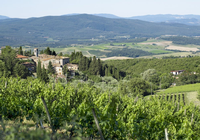 whether the differences were really due to the subzone or to the producer’s style. After all, when you taste a Chianti Classico made by Cecchi, whose base is in Castellina in Chianti, side-by-side with one made by Castello di Radda, whose vineyards lie in the Radda subzone, are you tasting the difference between producers or subzones? whether the differences were really due to the subzone or to the producer’s style. After all, when you taste a Chianti Classico made by Cecchi, whose base is in Castellina in Chianti, side-by-side with one made by Castello di Radda, whose vineyards lie in the Radda subzone, are you tasting the difference between producers or subzones?
Castello di Fonterutoli has eliminated that dilemma. Though situated in the south eastern corner of Castellina in Chianti, Castello di Fonterutoli has vineyards in Radda and Castelnuovo Berardenga in addition to their home base. They produced three wines in 2017, each of which comes from one of those subzones: Badiòla, a single-vineyard wine from Radda; Vicoregio 36, a single-vineyard bottling from Castelnuovo Berardenga; and Castello Fonterutoli, their flagship, a multi-vineyard blend, from Castellina in Chianti. Thanks to Zoom® and their importer, Taub Family Selections, Giovanni Mazzei, Fonterutoli’s export manager, commented on the wines as a group of us tasted them side-by-side.
Before getting to the wines, here’s a little background. Chianti Classico is the heart and most important subregion of the greater Chianti area, which extends from Florence to Siena in Tuscany. “Gran Selezione” is a recently created category that sits at the pinnacle of the Chianti Classico quality pyramid, above Riserva. It represents about six percent of Chianti Classico’s total production. To put that into perspective, Burgundy’s Grand and Premier Cru wines account for 11 percent of that region’s production. No stranger to Chianti Classico, the Mazzei family has owned Castello di Fonterutoli since 1435, which means that Giovanni represents the 25th generation.
Castello di Fonterutoli, Chianti Classico Gran Selezione, “Badiòla” 2017 ($99, 93 pts): 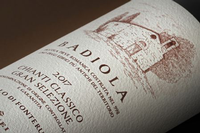 Mazzei believes that the vineyard’s southern exposure and high elevation (almost 1900 feet above sea level) combines great sunlight with large diurnal temperature variation, the combination of which results in ripeness and freshness. This finesse-filled wine delivers bright fresh red cherry-like notes mingled with mineral nuances. It has the racy energy of Chianti Classico combined with great elegance supported by suave tannins. Mazzei calls it a “vertical” wine. Mazzei believes that the vineyard’s southern exposure and high elevation (almost 1900 feet above sea level) combines great sunlight with large diurnal temperature variation, the combination of which results in ripeness and freshness. This finesse-filled wine delivers bright fresh red cherry-like notes mingled with mineral nuances. It has the racy energy of Chianti Classico combined with great elegance supported by suave tannins. Mazzei calls it a “vertical” wine.
Castello di Fonterutoli, Chianti Classico Gran Selezione “Castello Fonterutoli” 2017 ($74, 94 pts): The grapes for Castello, as Mazzei calls it, come from 11 different plots around the hamlet of Fonterutoli. Each plot is vinified separately, allowing precision in constructing the blend. The 2017 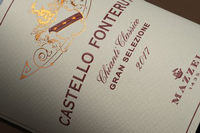 is the first year the wine was made entirely from Sangiovese. In the past, they included small amounts of Colorino and Malvasia Nera, but Mazzei noted that after 25 years of research with Sangiovese, they finally decided that was the way forward. It’s slightly higher alcohol, 13.8% compared to 13.57% for the Badiòla, reflects just a touch more ripeness. Indeed, the flavor profile tends toward darker cherry notes in this slightly weightier wine. Suave tannins, a hallmark of all of wines from Castello di Fonterutoli, lend support. It’s another racy and elegant wine. is the first year the wine was made entirely from Sangiovese. In the past, they included small amounts of Colorino and Malvasia Nera, but Mazzei noted that after 25 years of research with Sangiovese, they finally decided that was the way forward. It’s slightly higher alcohol, 13.8% compared to 13.57% for the Badiòla, reflects just a touch more ripeness. Indeed, the flavor profile tends toward darker cherry notes in this slightly weightier wine. Suave tannins, a hallmark of all of wines from Castello di Fonterutoli, lend support. It’s another racy and elegant wine.
Castello di Fonterutoli, Chianti Classico Gran Selezione “Vicoregio 36” 2017 ($99, 93 pts): 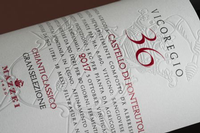 The Mazzei family planted 36 biotypes of Sangiovese in their Vicoregio vineyard in Castelnuovo Berardenga. Hence the name of the wine. This one, the deepest of the trio, conveys black cherry-like flavors, bordering on plumy ones, reflecting the warmth of Castelnuovo Berardenga. Still, it retains incredible freshness and vibrancy. Mazzei characterizes it as a “wider” wine compared to the “vertical” Badiòla. The Mazzei family planted 36 biotypes of Sangiovese in their Vicoregio vineyard in Castelnuovo Berardenga. Hence the name of the wine. This one, the deepest of the trio, conveys black cherry-like flavors, bordering on plumy ones, reflecting the warmth of Castelnuovo Berardenga. Still, it retains incredible freshness and vibrancy. Mazzei characterizes it as a “wider” wine compared to the “vertical” Badiòla.
Though the winemaking is not identical for the three wines, with oak aging varying slightly, and the age of the vines differing in the three subzones, the wines are all made entirely from Sangiovese and at the same winery. Most critically, the winemaking philosophy is the same. So, the differences among the wines reflect their respective subzones of Chianti Classico.
The wines can be purchased as a set of three. This allows consumers to hold a tasting with a small group of friends, complying, of course, with local regulations regarding size of gatherings, to see for themselves how the wines from Chianti Classico, similar to Burgundy or Barolo, differ according to where the grapes grow.
Posted by Michael Apstein at 12:27 PM
|
|
November 18, 2020
The Thanksgiving table is often seen as a challenge
by those who seek to serve the perfect wine with every meal. The
combination of sweet and savory flavors, and the sheer number of
courses, do present a bit of a gauntlet for the average wine
enthusiast. I take a slightly different approach.
I look at the Thanksgiving table as an opportunity. Start with the
premise that there is no one wine that suits each course and pleases
every palate.
The obvious solution is to go all out. I begin with the place setting.
In my opportunistic scenario, I set out four wine glasses. There would
be a glass for the bubbly. Another glass for a rich, complex white
wine. A third glass for a soft, juicy red packed with abundant fruit.
The fourth is for a sweet, but not too sweet dessert wine.
The bubbly is my celebratory aperitif wine. It need not be expensive,
though given  the fact this kicks off the holiday season something a
little bit special seems to be appropriate. Two of my favorites are the
Domaine Carneros by Taittinger Cuvée de la Pompadour Brut Rosé (about
$40) and the J Vineyards Cuvée 20 Brut (about $30). Both of these wines
are among the finest of their kind produced in the United States and
always crowd pleasers. the fact this kicks off the holiday season something a
little bit special seems to be appropriate. Two of my favorites are the
Domaine Carneros by Taittinger Cuvée de la Pompadour Brut Rosé (about
$40) and the J Vineyards Cuvée 20 Brut (about $30). Both of these wines
are among the finest of their kind produced in the United States and
always crowd pleasers.
But we are blessed to have a number of outstanding domestic sparkling
wine producers. You won’t go very wrong with anything from Iron Horse,
Roderer Estate, Schramsberg, Mumm Napa Valley or Domaine Chandon. And
if you’re watching the budget, Barefoot Bubbly produces delicious
bubblies in the $10 range.
By the time you move on to the white wine offering you will notice the
Thanksgiving table is crowded with roast turkey, stuffing, mashed
potatoes, sometimes candied sweet potatoes and typically a green
vegetable that has been enhanced with caramelized nuts of one type or
another. The stuffings, too, can be all over the map with savory notes
of sage, pepper, onion and sausage combined with sweet notes of currant,
golden raisins, apples or even cranberries.

For me, a light, tart white simply doesn’t cut it. If ever there is a
time for a layered, complex Chardonnay with hints of spice, this is it.
Can’t miss Chardonnay from the likes of Dutton Goldfield, Merry
Edwards, Tongue Dancer or Gary Farrell (all in the $40 to $60 price
range) will find room at my Thanksgiving table. Slightly less expensive
but also very good are Morgan, Eberle, Rodney Strong, Chateau St. Jean
and Souverain.
Alternatives abound. Dry Riesling from Smith-Madrone, Trefethen,
Chateau Ste. Michelle or Stony Hill are classic and have the depth and
complexity to hold up against the onslaught of Thanksgiving flavors.
Pinot Gris from Oregon’s King Estate or Ponzi also are up to the
Thanksgiving challenge. All of these wines can be found for less than
$40 a bottle, and the Ste. Michelle (slightly off-dry) is a steal at $10
or less. Even Ste. Michelle’s higher-end Eroica Riesling at less than
$20 is a bargain.
In my humble opinion, the red wine in your glass on Thanksgiving should
be supple, fruit driven and juicy on the palate, for all of the reasons
stated above. A young, tannic red would dominate everything at the
table and clash with the sweeter elements. Not good, but again that’s a
matter of taste and my palate prefers easy drinking reds.
Those would be Pinot Noir, Beaujolais, red Rhône blends, etc. The U.S.
has an embarrassment of riches when it comes to Pinot Noir. The top
producers are many  of the same that make outstanding Chardonnay, which
stands to reason because both are Burgundian grape varieties. of the same that make outstanding Chardonnay, which
stands to reason because both are Burgundian grape varieties.
My personal who’s who includes Dutton Goldfield, Tongue Dancer, ROAR and
Merry Edwards. They primarily produce vineyard-designate Pinots that
range up to $70 a bottle, so very expensive. Merry Edwards also
produces an appellation-specific Pinot from the Russian River Valley
that is more modestly priced at under $50.
Slightly less expensive but also very good is Siduri and Clarice, both
inspired by the winemaker Adam Lee. Siduri and Clarice both provide
vineyard-designated Pinots and appellation specific Pinots that are
excellent. Most of these wines can be found for less than $50 retail.
 Beaujolais has long been considered a perfect turkey wine for the
reasons mentioned here. Made from the Gamay grape, it is fruity, low in
tannin and ready to drink young. It goes down easily and is far less
expensive than domestic Pinot Noir. The most accessible Beaujolais in
America is Georges Duboeuf. The most expensive Duboeuf Beaujolais, the
wines from the crus villages such as Morgon or Fleurie, retail for less
than $30 a bottle. They are often sensational wines. Beaujolais has long been considered a perfect turkey wine for the
reasons mentioned here. Made from the Gamay grape, it is fruity, low in
tannin and ready to drink young. It goes down easily and is far less
expensive than domestic Pinot Noir. The most accessible Beaujolais in
America is Georges Duboeuf. The most expensive Duboeuf Beaujolais, the
wines from the crus villages such as Morgon or Fleurie, retail for less
than $30 a bottle. They are often sensational wines.
The less expensive Beaujolais Villages or AOC Beaujolais generally
retail for less than $20 a bottle. Same for the Côtes-du-Rhône reds
from the top producer Guigal. The Guigal Côtes-du-Rhône often retails
for less than $15. They are impeccably made and a steal at those
prices. From the standpoint of price, the Duboeuf Beaujolais and Guigal
Côtes-du-Rhône reds are among the greatest value wines coming out of
France. Domestically, Eberle’s Côtes-du-Robles Rouge at $30 will give
the Guigal wines a run for the money. Which brings me to the finale,
the dessert glass.

Personally, I prefer a dessert wine that is sweet but not sticky sweet.
The Eberle Muscat Canelli (the 2019 vintage is now available) is
exactly what I’m looking for. This wine has exquisite balance, a touch
of sweetness and a spice note that is beautiful with, you guessed it,
pumpkin pie!
__________________________________
Find full reviews of these wines and others
you might enjoy on your Thanksgiving table
Posted by Robert Whitley at 12:11 PM
|
|
November 11, 2020
Congressman Thompson can be found working hard in the halls of Congress … or in the rows of his vineyard. He recently won re-election, and next year will begin his 12th term in the U.S. House of Representatives, where he will continue to advocate vehemently for the wine community. Thompson serves California's 5th Congressional District, including all of Napa and parts of Contra 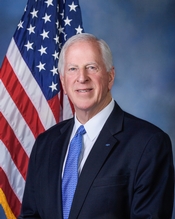 Costa, Lake, Solano, and Sonoma Counties. The Congressman was born in the Napa Valley and continues to reside there with his family. He also owns a 20-acre vineyard in Lake County. Costa, Lake, Solano, and Sonoma Counties. The Congressman was born in the Napa Valley and continues to reside there with his family. He also owns a 20-acre vineyard in Lake County.
Thompson, who is a member of the powerful House Ways and Means Committee, introduced and advanced a resolution recognizing the significance of the Napa Valley victory at the 1976 Paris Wine Tasting, and co-founded the bipartisan Congressional Wine Caucus. Today, the Caucus brings together 195 bipartisan, bicameral Members of Congress working on wine education and wine-related policy issues.
I had the pleasure of connecting with the Congressman by phone to discuss the recent perils facing his district. Winemaking always has an inherent risk, but 2020 has produced more challenges than ever anticipated, with fires early in the season and the COVID pandemic significantly impacting all wine industry facets, including restaurants and retailers. While fires are not new to the area, the Congressman explained that in previous years, the fires came late in the season when a limited amount of grapes were left on the vines. This year the fires came early, moving from a tragedy for some to an existential threat to the entire industry.
To address some of these hardships, Congress passed the Coronavirus Aid, Relief, and Economic Security (CARES) Act, which in part dedicated $9.5 billion in assistance to agricultural producers and an additional $14 billion in funding to the United States Department of Agriculture (USDA) to create an aid package for farmers who have seen a crash in commodity prices due to the COVID-19 pandemic. Building on the CARES Act, Congressman Thompson is leading the effort to reauthorize the Wildfire and Hurricane Indemnity Program-Plus (WHIP+) that provides disaster payments to producers to offset losses from hurricanes, wildfires, and other qualifying natural disasters. The funding is essential to support those who have experienced extreme devastation from the recent fires and the COVID pandemic.
On our call, the Congressman told stories of family-owned estates whose grapes will soon rot as wineries have backed out of purchase agreements, concerned that wildfire smoke has damaged the fruit. Without adequate research, growers and winemakers have few tools to prevent or rectify problems associated with smoke-damaged grapes. Numerous growers reported wineries not accepting grapes until laboratory tests were conducted to ascertain if smoke compounds were present. However, the few commercial labs serving the industry were extremely backlogged due to COVID plus the sheer extent of the fires – resulting in many broken contracts. In other instances, wineries elected not to harvest and produce a 2020 vintage, significantly impacting the immigrant workforce hired to harvest grapes. For immigrants who have lost their jobs or homes, the road to stability is incredibly steep, as many are ineligible for federal aid.
As fires and the correlating smoke taint remain an ongoing threat, the Congressman is laser-focused on several congressional initiatives to help the community rebuild. He hopes to expand smoke taint research funding through the USDA, develop fire science research/fire prevention work through tax code incentives, and find opportunities to support his district's essential immigrant workforce. For all these efforts, he is working across the aisle and in coordination with members of Congress from other impacted wine-growing states like Washington and Oregon.
The Congressman has always played an outsized role, ensuring that grape growers, winemakers, and the wine workforce thrive. Now his advocacy role has grown further as he must react to crisis after crisis. Yet, despite what appears like an uphill battle, the Congressman noted that "the community is resilient and innovative." He also remarked about the significant philanthropic impact of efforts like Auction Napa Valley, which the Congressman volunteers for each year.
When I pressed the Congressman on how those outside the area could best help the beloved community recover and rebuild, he said, "drink more California wine!" I imagine that is an easy task for our WRO readers. So, please order from your favorite CA wineries and sign up for a virtual tasting –drinking a little wine can go a long way!
Beyond buying California wine and visiting the Napa and Sonoma region (which—I can attest after a recent visit—is still idyllic despite the recent fires), there are other ways to help, like donating to the Napa Valley Community Foundation. Finally, encourage your members of Congress to join the effort led by Congressman Thompson to support an extension of the Wildfire and Hurricane Indemnity Program Plus (WHIP+).
Posted by Miranda Franco at 2:49 PM
|
|
November 4, 2020
Champagne Ayala was created in 1860 by Edmond de Ayala in the town of Aÿ in the Champagne region of northern France. His brother Fernand helped build the business from London, introducing the wine to British society. In 1865 they introduced a wine that set it apart from most other Champagnes. Until the mid-1800s, most Champagnes were sweet. According to Hugh Johnson’s The Story of Wine (1989), the sweetness added to a Champagne before final bottling, called dosage, varied from 22 to 330 grams per liter. That is 2.2 percent to 33 percent 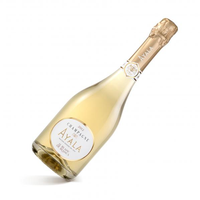 sweetness…so we’re talking dessert wine territory. Ayala’s Champagne had 7 grams per liter or .07 percent dosage, a level that continues today. sweetness…so we’re talking dessert wine territory. Ayala’s Champagne had 7 grams per liter or .07 percent dosage, a level that continues today.
The company’s heyday was in the 1920s when with 100 workers, they were producing over a million bottles a year. After World War II, business was quieter selling 400,000 bottles. In 2005 the Bollinger family, who have a bit of a reputation for their Champagne, bought Ayala.
Today Ayala is in the hands of two Bollinger alumni. Hadrien Mouflard is General Manager, youngest General Manager in all of Champagne. Caroline Latrive, the Cellar Master, is one of only four women in Champagne to hold that title. At Ayala the focus is on Chardonnay, and Latrive considers herself a major fan of Chardonnay. She is particularly pleased with the 2013 Le Blanc de Blancs ($76, Vintus) that she describes as the “essence of Chardonnay.” The grapes are from Grand Cru vineyards in Cramant, Chouilly and Le Mesnil-sur-Ogier and Premier Cru vineyards in Cuis and Vertus.
Brut “Majeur” ($45, Vintus) is the wine that defines the ‘fresh, elegant house style.” It is made from equal parts Chardonnay and Pinot Noir with 20 percent Pinot Meunier. Its elegant pale golden 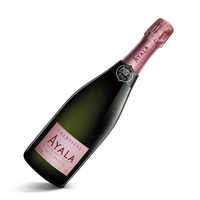 color shines with the tiniest bubbles and delightful aromas of apples, citrus, fresh flowers with yeasty notes. Flavors of apple, peach, lemon and a bit of freshly baked croissant are round and supple, while vibrant acidity and spirited bubbles bring focus and balance. color shines with the tiniest bubbles and delightful aromas of apples, citrus, fresh flowers with yeasty notes. Flavors of apple, peach, lemon and a bit of freshly baked croissant are round and supple, while vibrant acidity and spirited bubbles bring focus and balance.
The Rosé “Majeur” ($57, Vintus) displays a pretty, golden pink color with luscious strawberry, raspberry, citrus, and chalky aromas that introduce round berry, citrus, and toasty almond flavors. The senses are enhanced with delicate bubbles tingling on the tongue. Fifty percent of the blend is Chardonnay. Pinot Noir is 40 percent, with six percent coming from still wine destined to impart the delicate pink rosé color. Pinot Meunier completes the blend. All three are Champagnes that richly deserve your attention.
Posted by Rebecca Murphy at 7:11 PM
|
|
 |
|